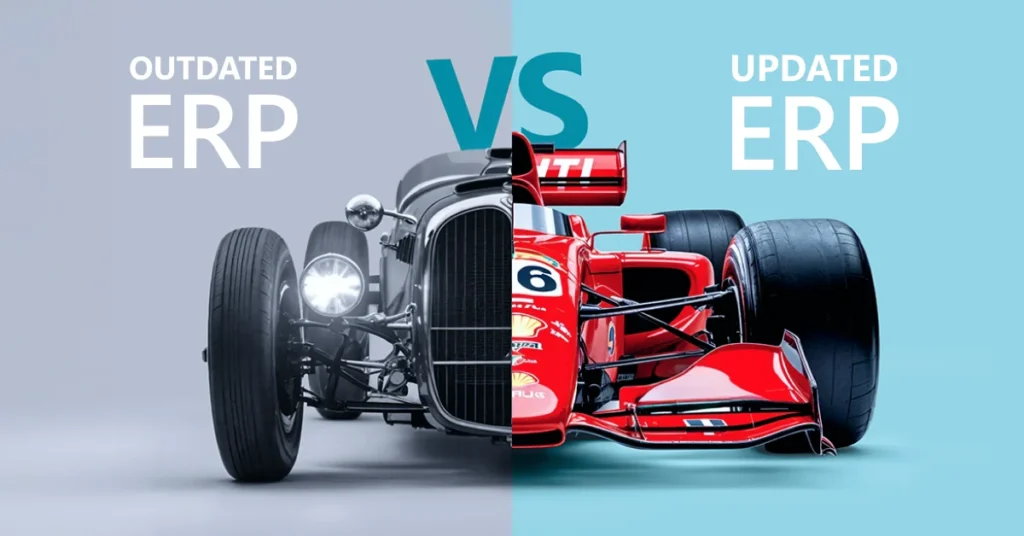In today’s fast-paced business environment, maintaining an updated ERP system is not just a technical necessity but a strategic imperative. Drawing on SMART business`s many years of experience working with international and local clients across various industries and countries, we have seen firsthand how an updated ERP system can significantly contribute to business growth and efficiency.
From our perspective, companies that embrace regular, incremental updates to their ERP systems avoid the pitfalls of technical debt and functionality gaps. These businesses follow a steady path of progress, making small but consistent improvements with each system update. In contrast, other companies take the opposite approach – freezing the update process for several years and then undertaking a massive overhaul. This strategy often leads to significant challenges and risks.
Challenges of Delayed ERP Updates
Organizations that delay ERP updates for years often face the following issues:
- Increased Costs: The cost of implementing a major system overhaul after years of stagnation is substantially higher than regular, incremental updates. The need for extensive internal resources and a large budget further compounds the challenge.
- Functional Downgrades: When new functionality becomes available, adapting it to an outdated system becomes increasingly difficult. In many cases, companies are forced to downgrade their processes to fit the old system.
- User Relearning: After a prolonged gap, users must essentially relearn the system from scratch when a new version is finally implemented. This can lead to productivity losses and higher training costs.
- Higher Risks: Transitioning to a new system after several years is a complex and risky process. It often involves rewriting code, making significant decisions under pressure, and managing potential disruptions to business operations.
Benefits of Regular Updates
Microsoft and SMART business strongly recommend a different approach: adopting a strategy of regular updates. This approach offers numerous advantages:
- Efficiency: With each new version, companies can quickly learn and adapt to a small set of changes, making the upgrade process straightforward and secure.
- Access to Modern Technology: By staying up-to-date, businesses can leverage the latest innovations, solutions, and technologies without compatibility concerns.
- Up-to-Date Documentation: Microsoft’s continuous updates ensure that system documentation remains current, reducing the need for significant internal effort.
- Risk Mitigation: Incremental updates eliminate the risks associated with large-scale migrations, such as downtime, data loss, or system failures.
In the long run, this approach simplifies ERP management, transforming it into a seamless and continuous process. Businesses can focus on growth rather than troubleshooting outdated systems.
Security and Compliance
Security is another critical reason to prioritize ERP updates. Microsoft invests heavily in identifying and addressing risks that arise globally. Each new version of the ERP system incorporates solutions to mitigate emerging threats, ensuring robust protection for businesses. In contrast, older versions lack these safeguards, exposing companies to unnecessary vulnerabilities.
Additionally, legislative changes often require quick and precise system adjustments. Downgrading an old version to meet new compliance standards can be both risky and complex. By staying updated, businesses can implement these changes effortlessly and avoid inconsistencies or disruptions.
Financial Considerations
While some companies view regular updates as an expense, the alternative – a large-scale overhaul every five years – is far more costly. Beyond the direct costs of implementation, businesses incur expenses for downgrades and functionality gaps. Over time, the cumulative cost of not improving the system outweighs the investment in regular updates.
Using an outdated ERP system is akin to running a racetrack backwards – it’s counterproductive and inefficient. Eventually, the price of catching up becomes unavoidable, and the missed opportunities during those years of stagnation add up to a significant loss.
An updated ERP system is a cornerstone of modern business success. By embracing a culture of continuous improvement and regular updates, companies can ensure their operations remain efficient, secure, and competitive. Our extensive experience has shown that this proactive approach leads to better outcomes, reduced risks, and long-term cost savings. It’s not just about technology; it’s about building a resilient foundation for future growth.



